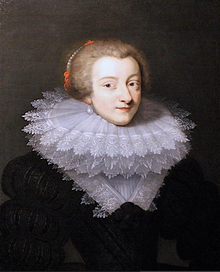Marie de Rohan-Montbazon, duchesse de Chevreuse
Marie Aimée de Rohan-Montbazon, duchesse de Chevreuse (December 1600 - August 12, 1679 in Gagny , France ) was famous for her love affairs and intrigues.
Her life was determined by her affairs, her friendship with Anna of Austria and her hostility to Cardinal Richelieu and later Cardinal Mazarin , against whom she spun numerous unsuccessful intrigues and conspiracies. One of her lovers was the French writer François de La Rochefoucauld .
biography
Family and childhood
Marie de Rohan-Montbazon came from an old noble family who traced their descent to the pre-Roman princes of Brittany . Her father was Hercule de Rohan , Duke of Montbazon and Count of Rochefort-en-Yvelines , a confidant of King Henry IV. , Of the dignities of a peer of France , grand veneur de France and Governor of Paris and the Ile-de-France held .
Her mother, Madeleine de Lenoncourt , died when Marie was two years old. Together with her two years older brother, she grew up at Couzières Castle in the care of servants. The siblings were inseparable. Marie is said to have often worn her brother's clothes and to have passed the time with him and his friends riding, hunting and horse racing.
Marriages

When Louis XIII. was married to Anna of Austria in 1615, Marie was chosen for the court of the young queen and caused quite a stir at the court with her enterprising spirit, her unbridled zest for life and her extraordinary beauty. After King Louis XIII's favorite at the time, Charles d'Albert, duc de Luynes , had become the most influential man in France with the successful coup against Concino Concini , he asked for her hand and took her as his wife on September 13, 1617. There were two children from this marriage:
- Louis Charles , Duc de Luynes (* December 25, 1620 in the Louvre , † October 20, 1699 in Paris)
- Anne Marie (* 1622 in the Louvre; † September 21, 1646)
King Ludwig was enthusiastic about the young woman, who like him was enthusiastic about horses, hunting and falconry, and made her the Queen's first lady-in-waiting after the birth of her first child. She quickly rose to become Anna's closest confidante. After Luynes death on December 15, 1621, she married Claude de Lorraine , Duke of Chevreuse, on April 21, 1622 . She had three daughters with him:
- Anne Marie, Abbess of Pont-aux-Dames (* 1624 - † August 5, 1652 in Paris)
- Charlotte-Marie (* 1627 - † November 7, 1652 in Paris)
- Henriette, Abbess of Jouarre (* 1631 - † January 25, 1693 in Paris)
intrigue
In 1625 she initiated a liaison between Anna and George Villiers, 1st Duke of Buckingham . In 1626 she and her lover, Henri de Talleyrand-Périgord , the Count of Chalais, were involved in a plot to murder Richelieu, which the cardinal was able to uncover. Chalais was executed and Marie exiled to Poitou . She withdrew to the Lorraine court and won Duke Charles IV for Buckingham's anti-French coalition. In 1628 she was allowed to return to France.
In 1633 she was exiled to Tours because she should have eavesdropped on her lover, the royal keeper of the seals Charles de L'Aubespine , Marquis de Châteauneuf, and betrayed state secrets to Spain. In 1637, when France was now at war with Spain, Richelieu discovered that Queen Anne was using her to maintain a treacherous correspondence with her Spanish relatives. The Duchess then fled to Spain. This time she was only able to return to France after the death of the king and cardinal.
But her relationship with the queen broke up because of her affection for Cardinal Mazarin , who thereby became a target for Marie's enmity. She participated in the Cabale des Importants to assassinate Mazarins and was exiled again, but at the beginning of the Fronde she returned and joined the party of the Prince of Condé, Louis II. De Bourbon, prince de Condé .
In 1652 she reconciled with the queen and finally withdrew from the political stage.
Survival
Marie's affair with Chalais is at the center of the opera Maria di Rohan by Gaetano Donizetti (1843). Her role in the affair between Anna and Buckingham also inspired Alexandre Dumas , who made her appear as the mysterious lover of his musketeers Aramis and Athos in The Three Musketeers .
literature
- Dorothy De Brissac Campbell: The Intriguing Duchess . Covici Friede Publishers, New York 1930.
- Michael Prawdin: Marie De Rohan Duchesse De Chevreuse . George Allen & Unwin Ltd, London 1971.
- Louis Batiffol: Marie von Rohan, Duchess von Chevreuse, A portrait of the greatest intriguer of the 17th century, 2nd edition, German translation by Else and Hermann Warlich, Julius Hoffmann Verlag, Stuttgart, 1914
Web links
| personal data | |
|---|---|
| SURNAME | Chevreuse, Marie de Rohan-Montbazon, duchesse de |
| ALTERNATIVE NAMES | Chevreuse, Marie Aimée de Rohan-Montbazon de |
| BRIEF DESCRIPTION | French nobles and frondeuse |
| DATE OF BIRTH | December 1600 |
| DATE OF DEATH | August 12, 1679 |
| Place of death | Gagny , France |
